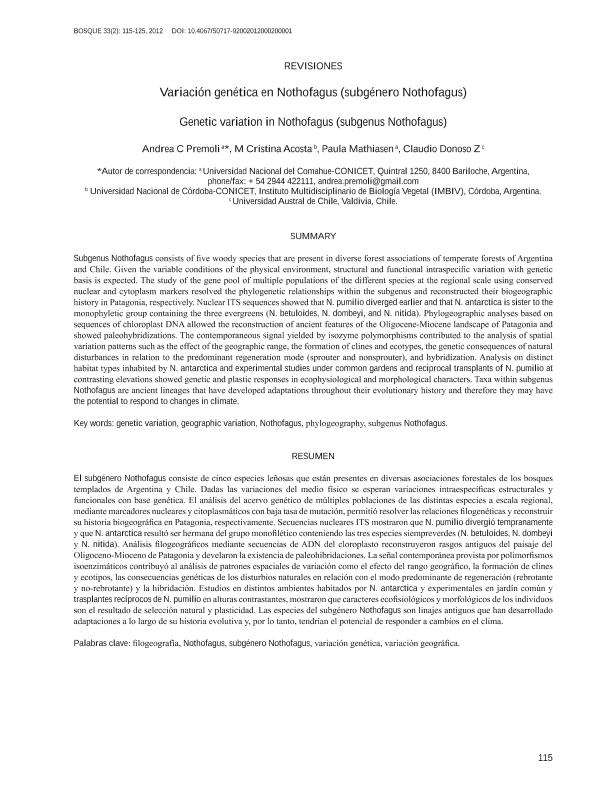Mostrar el registro sencillo del ítem
dc.contributor.author
Premoli Il'grande, Andrea Cecilia

dc.contributor.author
Acosta, María Cristina

dc.contributor.author
Mathiasen, Paula

dc.contributor.author
Donoso, Claudio
dc.date.available
2017-06-22T18:07:33Z
dc.date.issued
2012-07
dc.identifier.citation
Premoli Il'grande, Andrea Cecilia; Acosta, María Cristina; Mathiasen, Paula; Donoso, Claudio; Variación genética en Nothofagus (subgénero Nothofagus); Universidad Austral de Chile; Bosque (Valdivia); 33; 2; 7-2012; 115-125
dc.identifier.issn
0304-8799
dc.identifier.uri
http://hdl.handle.net/11336/18660
dc.description.abstract
El subgénero Nothofagus consiste de cinco especies leñosas que están presentes en diversas asociaciones forestales de los bosques templados de Argentina y Chile. Dadas las variaciones del medio físico se esperan variaciones intraespecíficas estructurales y funcionales con base genética. El análisis del acervo genético de múltiples poblaciones de las distintas especies a escala regional, mediante marcadores nucleares y citoplasmáticos con baja tasa de mutación, permitió resolver las relaciones filogenéticas y reconstruir su historia biogeográfica en Patagonia, respectivamente. Secuencias nucleares ITS mostraron que N. pumilio divergió tempranamente y que N. antarctica resultó ser hermana del grupo monofilético conteniendo las tres especies siempreverdes (N. betuloides, N. dombeyi y N. nitida). Análisis filogeográficos mediante secuencias de ADN del cloroplasto reconstruyeron rasgos antiguos del paisaje del Oligoceno-Mioceno de Patagonia y develaron la existencia de paleohibridaciones. La señal contemporánea provista por polimorfismos isoenzimáticos contribuyó al análisis de patrones espaciales de variación como el efecto del rango geográfico, la formación de clines y ecotipos, las consecuencias genéticas de los disturbios naturales en relación con el modo predominante de regeneración (rebrotante y no-rebrotante) y la hibridación. Estudios en distintos ambientes habitados por N. antarctica y experimentales en jardín común y trasplantes recíprocos de N. pumilio en alturas contrastantes, mostraron que caracteres ecofisiológicos y morfológicos de los individuos son el resultado de selección natural y plasticidad. Las especies del subgénero Nothofagus son linajes antiguos que han desarrollado adaptaciones a lo largo de su historia evolutiva y, por lo tanto, tendrían el potencial de responder a cambios en el clima.
dc.description.abstract
Subgenus Nothofagus consists of five woody species that are present in diverse forest associations of temperate forests of Argentina and Chile. Given the variable conditions of the physical environment, structural and functional intraspecific variation with genetic basis is expected. The study of the gene pool of multiple populations of the different species at the regional scale using conserved nuclear and cytoplasm markers resolved the phylogenetic relationships within the subgenus and reconstructed their biogeographic history in Patagonia, respectively. Nuclear ITS sequences showed that N. pumilio diverged earlier and that N. antarctica is sister to the monophyletic group containing the three evergreens (N. betuloides, N. dombeyi, and N. nitida). Phylogeographic analyses based on sequences of chloroplast DNA allowed the reconstruction of ancient features of the Oligocene-Miocene landscape of Patagonia and showed paleohybridizations. The contemporaneous signal yielded by isozyme polymorphisms contributed to the analysis of spatial variation patterns such as the effect of the geographic range, the formation of clines and ecotypes, the genetic consequences of natural disturbances in relation to the predominant regeneration mode (sprouter and nonsprouter), and hybridization. Analysis on distinct habitat types inhabited by N. antarctica and experimental studies under common gardens and reciprocal transplants of N. pumilio at contrasting elevations showed genetic and plastic responses in ecophysiological and morphological characters. Taxa within subgenus Nothofagus are ancient lineages that have developed adaptations throughout their evolutionary history and therefore they may have the potential to respond to changes in climate.
dc.format
application/pdf
dc.language.iso
spa
dc.publisher
Universidad Austral de Chile

dc.rights
info:eu-repo/semantics/openAccess
dc.rights.uri
https://creativecommons.org/licenses/by-nc-sa/2.5/ar/
dc.subject
Filogeografía
dc.subject
Nothofagus
dc.subject
Subgénero Nothofagus
dc.subject
Variación Genética
dc.subject
Variación Geográfica
dc.subject.classification
Ciencias de las Plantas, Botánica

dc.subject.classification
Ciencias Biológicas

dc.subject.classification
CIENCIAS NATURALES Y EXACTAS

dc.title
Variación genética en Nothofagus (subgénero Nothofagus)
dc.title
Genetic variation in Nothofagus (subgenus Nothofagus)
dc.type
info:eu-repo/semantics/article
dc.type
info:ar-repo/semantics/artículo
dc.type
info:eu-repo/semantics/publishedVersion
dc.date.updated
2017-06-16T15:53:12Z
dc.identifier.eissn
0717-9200
dc.journal.volume
33
dc.journal.number
2
dc.journal.pagination
115-125
dc.journal.pais
Chile

dc.journal.ciudad
Valdivia
dc.description.fil
Fil: Premoli Il'grande, Andrea Cecilia. Universidad Nacional del Comahue; Argentina. Consejo Nacional de Investigaciones Científicas y Técnicas; Argentina
dc.description.fil
Fil: Acosta, María Cristina. Consejo Nacional de Investigaciones Científicas y Técnicas. Centro Científico Tecnológico Conicet - Córdoba. Instituto Multidisciplinario de Biología Vegetal. Universidad Nacional de Córdoba. Facultad de Ciencias Exactas Físicas y Naturales. Instituto Multidisciplinario de Biología Vegetal; Argentina
dc.description.fil
Fil: Mathiasen, Paula. Universidad Nacional del Comahue; Argentina. Consejo Nacional de Investigaciones Científicas y Técnicas; Argentina
dc.description.fil
Fil: Donoso, Claudio. Universidad Austral de Chile; Chile
dc.journal.title
Bosque (Valdivia)

dc.relation.alternativeid
info:eu-repo/semantics/altIdentifier/url/http://ref.scielo.org/bwsdnq
dc.relation.alternativeid
info:eu-repo/semantics/altIdentifier/doi/http://dx.doi.org/10.4067/S0717-92002012000200001
Archivos asociados
